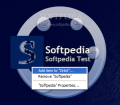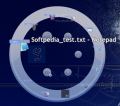The general idea launchers are built on is helping users improve their daily workflow, by accessing favorite, most used files or particular applications - all with a few mouse clicks or with the use of a few keystrokes. Of course, there are launchers that provide more options to choose from, but the principle they all rely on remains the same.
The application that I tested is called Orbit. From the start, I must say that I was impressed by the screenshots provided by the developer on his website, which was why I decided to test the application and see how it ran. Orbit was developed to be similar to Apple's dock, although there are differences between the two. A first one would be that Orbit does not stay on your desktop, so that you can access items from there, running instead in the background, from where it can be called using your mouse or the Win key+W combination.
The first thing one notices regarding this software is its great user interface, which can be customized in countless ways, so that absolutely any user can extend its functionality to best suit their liking. The practicality of Orbit’s GUI is divided in two modes – the first one being Transparent Mode. Orbit will snap to your mouse position (a very helpful feature when you are using a multi-monitor environment) on your desktop with a transparent background, and if you use all the provided transition effects, you will be surprised by the way the application looks. The second mode is the Non-transparent one. As its name implies, in this mode, the application will display an image on the background.
Also here, you can assign a specific color to be used as background, while also having transition effects at your disposal. There is yet another option that can be enabled when selecting this mode, and that is Use Fake Transparency, which will display the image or colored background, but will become transparent in about one second.
There is, however, a catch as regards both modes. For instance, I asked myself why the developer created the non-transparent mode as well, seeing how the application works and looks just fine in the transparent one. Well, as it happens, the answer was right under my nose, as they say. For starters, I looked into the Help file (I must add here that the app also comes with a great online manual), and then to the consumption table in Task Manager. Under Requirements, the developer says that, in order to run Orbit in non-transparent mode, you will need a 600Mhz Duron, while to be able to run it in transparent mode, you need a more powerful processor (a 1.4Ghz or higher CPU is recommended).
The configuration of the system that I tested the application on is: AMD 1.9GHz processor, 1G RAM, a GeForce MX440 video card running XP OS. I wanted to go with a configuration like this because I was sure that running Orbit on a system that had Vista or supported the installation of Vista OS would work out just fine. You will also need .NET Framework installed, a video card that supports Direct3D acceleration, DirectX 9.0 or higher installed.
The first endurance test that I performed was to use the Non-transparent Mode with the Use Fake Transparency option enabled. When I called Orbit, my processor got to 100% for a few seconds and the RAM level to ~42M. When not in use, the application eats about 35M of your RAM (the developer says in the Help File that “Orbit takes up from 15Mb to 30Mb of RAM”).
The second test was to use the Non-transparent Mode without Use of Fake Transparency enabled. When I called Orbit, the process recorded a small pulse, but nothing too significant, and the RAM level got to ~35M. The final test was to use the Transparent Mode with all the transition effects enabled. Now, this is where you note the difference between the two modes, as this one will definitely put your processor and RAM to work. No specific values can be given at this point, because there are variations depending on how and what Orbit does.
Orbit was designed to help you launch applications, files, websites, show the contents of a folder (meaning that you can add a folder location to “Orbit’s wheel,” and click to view the content of that folder). Orbit’s interface is like a wheel that you can control with the middle button of your mouse, or by using CTRL and the right mouse button to display the items. To add a file that needs to be launched with Orbit, you must select the category, and then customize the properties of that item.
Speaking of customization options, these consist of entering the name, a small description and, what’s also very important, the assignment of an icon, which can be either a default one or your own, the only prerequisite being that but it must be in PNG format. By default, Orbit comes with Internet, Windows Explorer, Applications and Tasks categories. The last one displays your current items from Taskbar.
After you configure and customize your “wheel,” you will probably want to save all the settings to keep them at hand. Coming to your aid, Orbit creates a folder named Profiles, where it stores all the configuration files that you create. A small test that I performed for this showed that one can copy the installation folder anywhere one wants for the program to work – so one can use the software from the flash drive.
A very important aspect you must bear in mind when you want to move the installation directory is to reset the default path for the images used by the application. So, if you are using, say, the default IE icons, but you have added your own icons for other items, it is recommended you copy them in the “Images” folder.
The Good
Orbit is basically a simple launcher with a complex and well designed user interface. The fact that it stores the profiles to installation folder, and given that it may be moved to another location makes it likely to be considered a portable software. However, make sure you don’t select any items from your portable disk to be launched, because Orbit does not remember relative path.
The Bad
The consumption table from Task Manager says that, if you plan on using the Transparent Mode (which, in my opinion, is the best way to benefit from all the features), you will need a strong configuration for your system. Then again, all the applications that have transition effects, spin or rotate within the interface usually require more components to run.
The Truth
Orbit is a good launcher that comes with a well-polished user interface, but that also requires a hardware configuration suitable for the provided features. There are not that many options to choose from when it comes to launching files, but Orbit compensates for that with the behavior of the user interface.
Here are some snapshots of the application in action:
 14 DAY TRIAL //
14 DAY TRIAL // 










